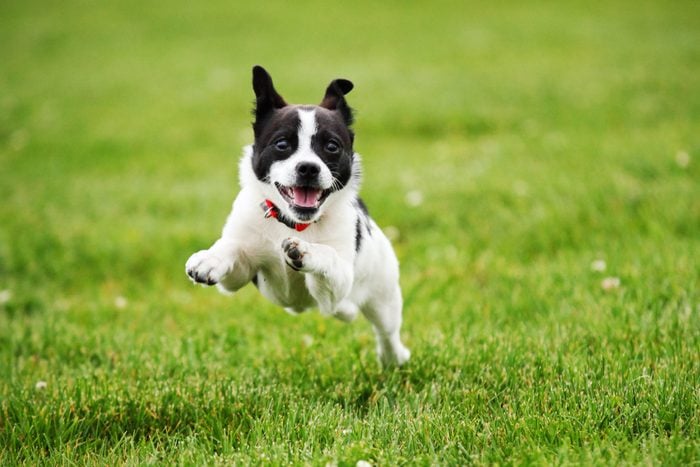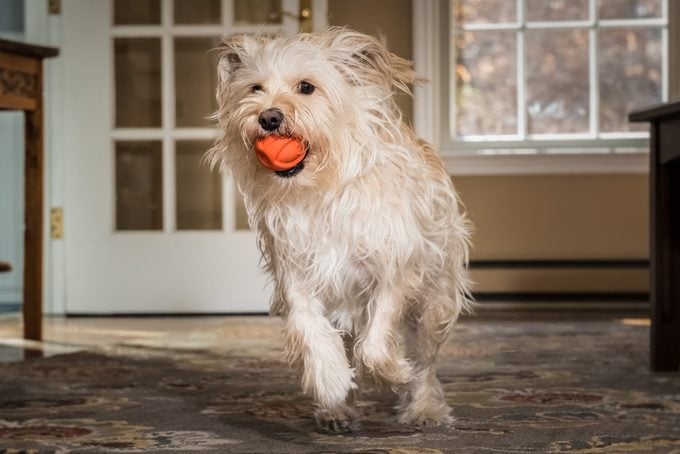Why Do Dogs Get the Zoomies?
Updated: Dec. 10, 2022

Contrary to popular opinion, this energetic and hyper behavior isn't always a sign of joy.
Almost every dog owner is familiar with the zoomies—those random bursts of energy that cause your pup to spin in circles, make a flying leap over the couch, or jet off as soon as you unhook their leash at the park. We know why dogs chase their tails, but why do dogs get the zoomies? Pet zoomies are definitely one of those hyper dog behaviors that pet owners have come to expect, but they actually have a technical name—frenetic random activity periods, or FRAPs—and can tell you a lot more about your pup’s mood, including levels of dog anxiety, than you might think.
According to the American Kennel Club, dog zoomies frequently occur when dogs have excess energy, especially physical energy that’s been contained (like if they’re crate-trained) or nervous energy (like when they’ve endured a grooming session). We asked an expert dog behaviorist to explain the common reasons dogs get the zoomies and how you should respond to them, if at all. And for more behaviors to be aware of, don’t miss the ways your dog may be asking for help.
Why does my dog get so hyper?
1. They are excited
In many cases, dog zoomies are caused by excitement and can occur whenever your pup gets into a high-energy state. Zoomies in puppies can occur after a bath, while your dog might spin in circles after a favorite family member comes home, or zoom around the house when they’re released from their crate. So, while zoomies might mean your dog is happy, they can also be a learned behavior that your dog has picked up to entertain you, especially if you tend to hype them up as they jet around. Similarly, there are certain noises your dog makes that they know get them extra treats. “It may be that the dog has learned that this is a way to instigate attention or to create a game,” says E’Lise Christensen, DVM, DACVB, a veterinarian and board-certified veterinary behaviorist.
2. They are anxious
On the flip side, dog zoomies could be a sign of discomfort. For example, if your pup tends to get the zoomies after a high-stress walk or a trip to the vet, the behavior could be a result of anxiety. “When we see them doing this burst of excitement, it isn’t always a happy excitement,” says Dr. Christensen. “Sometimes you’ll see that their facial muscles are really tense, their ears are back, their muscles are tense, and even if they’re wagging their tail, they’re not wagging their whole body.” If that’s the case, you may want to speak to a professional who can help you get to the root of the problem—and help you learn the things your dog wishes you knew.
How should owners respond to dog zoomies?

How do you calm a dog that’s deep in the zoomies? If your dog gets the zoomies on a regular basis, it’s worth mentioning the behavior to your vet or a professional who’s trained in behavior analysis. “When a client says zoomies to me, what I need to find out is: What does that look like, how long does it last, and what is causing it,” says Dr. Christensen. “And as we look at all those factors, we also want to figure out if it’s a problem for the family and if it’s a situation where the dog looks comfortable and happy or a situation where the dog looks uncomfortable or unhappy.”
From there, a professional can create a plan for your pup to help you cope. “The plan might be that the behavior is no big deal and to ignore it,” says Dr. Christensen. “But if it turns out that there are specific things that trigger these events—and especially if it turns out that these events don’t look like a dog that’s really comfortable and joyful and happy—then we may try and backtrack to find out when these events are happening and what’s triggering them.” Once you know the cause, you can work on a solution—for example, teaching the dog a new way to respond to the situation that doesn’t involve running around. In addition to zoomies, these behaviors mean your dog might need obedience training.
Ultimately, the goal is to make sure your dog is comfortable. “While I’m not trying to rain on anybody’s parade, sometimes dogs who are doing what people call the zoomies are not having fun,” says Dr. Christensen. “So we need to figure out which those animals are so we can treat them.” In order to know if your pet feels at ease, these are the telltale signs your dog is happy.
Sources:
- American Kennel Club: “Zoomies: Why Your Dog Gets Hyper & Runs in Circles”
- E’Lise Christensen, DVM, DACVB, veterinarian and board-certified veterinary behaviorist





















